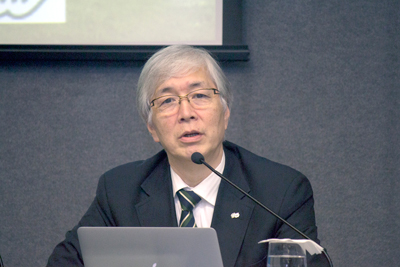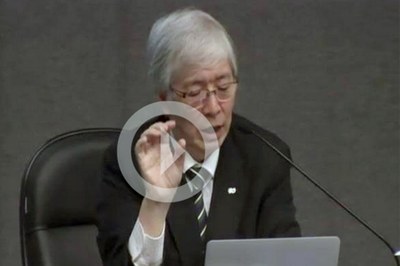The Relationship between Time and Astronomy in the Theory of Relativity
Time in Astronomy was the subject of the conference of Hideyo Kunieda, deputy dean of research and students at Nagoya University (Japan), at the Intercontinental Academia (ICA) on April 21.
Kunieda, who is also professor of the university’s Department of Physics, addressed in particular the advances in the observation of active galactic nuclei (AGNs) with the help of X-ray telescopes, his area of expertise.
According to him, this area of research has contributed substantially to the understanding of astronomical phenomena predicted by the Theory of Relativity, such as black holes, the bending of light, and the deformation of space-time in the presence of supermassive objects.
Related materialRelated news |
|---|
Echoes from the past
“The light of heavenly bodies we see today was emitted long ago. Looking into space is like looking into the past,” Kunieda said, noting that this is due to the huge scale of the universe: “The propagation of light in space is measured in years,” he added.
For the professor, one of the positive aspects of light’s “delay” is to make it possible to study the evolution of the universe over time, from the Big Bang to the present day.
According to the Big Bang theory, dominant among scientists, the universe came about 13.7 billion years ago, from a huge explosion. Planets, stars and galaxies were like splinters that progressively moved away from the center of detonation, causing the universe to expand continuously.
“The universe was fairly uniform after the Big Bang. But then the fragments grew and the stars and galaxies came about. We currently can observe a broad variety of objects,” said Kunieda.
According to him, to observe faint, lighted objects in space, with little glare, is like observing the early stages of the Big Bang, when the fragments began to take shape. “To look at distant galaxies is to see how these galaxies were in the early universe.”
The idea of a moving and expanding universe, a notion that underlies the Big Bang theory, was strongly influenced by Hubble’s Law, according to which there is a relationship between a galaxy’s distance from Earth and the speed with which it is moving away: the farther, the faster.
The law was formulated by observing a phenomenon known as “redshift,” or changes in the frequency of the waves that make up the spectrum of light caused by the relative velocity between the observer and the source of emission. If the object moves away from the observer at high speed, low frequency waves become more visible and their color is shifted toward red; and if the object is approaching, the high frequency waves become sharper and the color is shifted to violet.
Thus, it was ascertained that most galaxies display a redshift and that the greater the deviation, the greater the distance between said galaxies and the Earth. “By Hubble’s law, the time axis is converted into depth in space,” summed up Kunieda.
Black hole
Predicted by the Theory of Relativity, a redshift also occurs in the presence of a strong gravitational field. Kunieda’s research on active galactic nuclei (AGNs) is based on observations of this phenomenon through images captured by X-ray telescopes.
AGNs are supermassive (with mass up to 1 billion times that of our Sun) and very bright (up to 100 billion times brighter than the Sun) celestial bodies.
According to the professor, astronomical observations using different techniques suggest that AGNs harbor black holes – regions in space where gravity is so strong that nothing, not even light, can escape. Formed from the gravitational collapse of a star, known as supernova, black holes are the result of the curvature of space-time, the system of coordinate that underlies the Theory of Relativity.
“Near a black hole, space-time is more curved. Because of this, time seems slowed down and the light emanating from that region seems redder,” Kunieda said, referring to the gravitational redshift.
He explained that the brightness of AGNs does not derive from the black holes themselves, which are invisible, but from the radiation produced by the accretion disk – the agglomeration of particles and gases surrounding supermassive objects. Because they have a very powerful gravitational field, black holes suck in all surrounding matter. And when sucked in, matter does not fall into the hole in a straight path, but rather in spirals, like a whirlwind, giving rise to a disk that gradually adds mass to the central object.
According to Kunieda, the heat produced by matter moving toward the gravitational body radiates in the disk’s surface, which is visible. The redshift occurs under the action of gravity, which causes an increase in the length of the light waves. He said this phenomenon is the curvature of the light under the effect of gravity, as predicted by the Theory of Relativity.
The professor’s observations involve accretion disks in the center of host galaxies. He said images obtained by him and other researchers point to the existence of supermassive objects – in this case, black holes –, as determined by the Theory of Relativity.
 |
|---|
| Hideyo Kunieda, from the Nagoya University |
The Milky Way
In Kunieda’s assessment, certain images of the Milky Way provide evidence that black holes exist. Obtained through infrared radiation or x-rays, these images show at first a common galaxy, with no central bright object, and therefore devoid of an active nucleus.
However, stressed Kunieda, one cloud of particles at one end of the galaxy displays an unusual light pattern, as if it was lit from below and reflected the light emitted by an object in the vicinity. According to him, this is what astronomers refer to as “reflection nebula.”
“By measuring the distance between the reflection and the light source, one can calculate how long ago the light was emitted. The center of the galaxy was 10 million times brighter 350 years ago,” he said, noting that the reflection nebula provides evidence that the center of the Milky Way was once an AGN.
“It’s a kind of astronomical archeology. It allows us to look at past activities in the center of the galaxy,” he compared. "In this case, the time axis is converted in a two-dimensional distribution."
Supernovae
According to Kunieda, observations of supernovae (explosions that herald the beginning of the death of stars) have also contributed to our understanding of the history of the universe.
The professor explained that stars, like our Sun, are bright because of the nuclear fusion of hydrogen into helium, a process that results in loss of mass and the formation of an increasingly dense core.
When the fuel runs out, the core of the star shrinks and becomes a compact object, with an extremely strong gravitational field. The star then begins to attract all matter to its center, up to a point where the high density becomes unsustainable and the supermassive body collapses, expanding matter in a great explosion – the supernova. What remains of this collapse gives rise to black holes.
Kunieda stressed that “the records of these explosions are very useful to understand the evolution of supernova remnants that we see today.” The remnants are nebulae formed from material ejected during the gravitational collapse, which speed away from the core. “In this case, the time axis is converted in a two-dimensional intensity distribution,” he said.

